Stuffed eggs recipes have endured since their first documented appearance in 1786. Some classics never go out of style. Modern variations might add bacon or spicy elements, but I’ve found the traditional preparation remains unbeatable for its simplicity and flavor.
The simple recipe needs just 15 minutes of preparation time and uses ingredients like hard-boiled eggs, mayonnaise, and mustard. My grandmother’s traditional method produces the creamiest and most flavorful results. I can say this with confidence after trying countless stuffed egg recipes over the last several years. These eggs can be prepared up to two days ahead, which makes them perfect for busy hosts who want to serve a time-tested favorite.
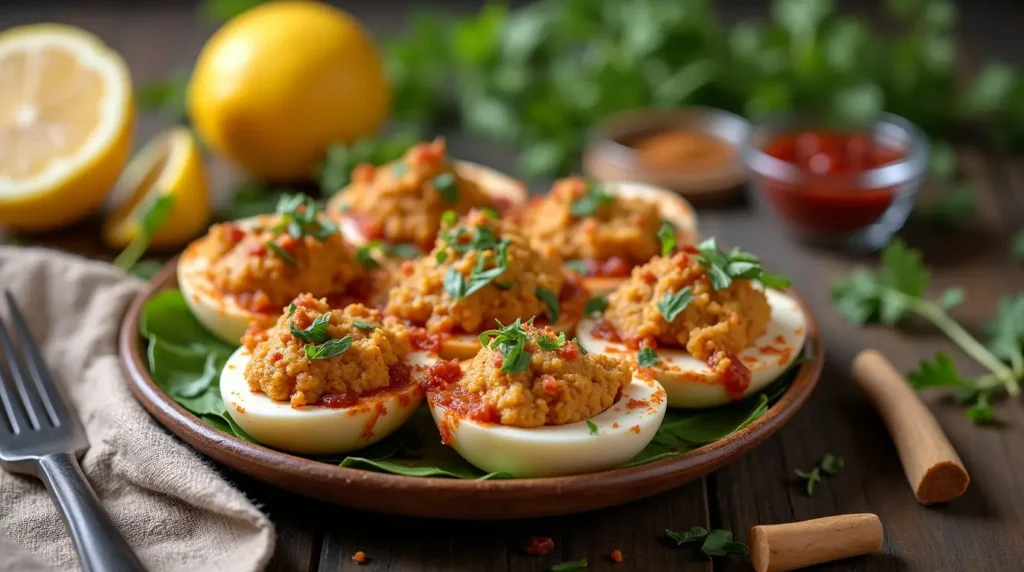
Let me share why my grandmother’s stuffed eggs recipe continues to outshine modern interpretations in this piece. You’ll learn the techniques and ingredients that make it truly special.
Table of Contents
The Secret Behind Grandma’s Perfect Stuffed Eggs Recipe
My grandmother’s time-tested methods are the secret behind making perfect stuffed eggs recipe. Years of preparing these family favorites taught me that proper technique matters more than fancy ingredients or modern shortcuts.
Traditional egg preparation techniques
Most people think boiling eggs is the way to go, but steaming gives better results. I found that steaming needs less water and works faster. To make perfect stuffed eggs, I add just half an inch of water to a large pan, bring it to a simmer over high heat, and steam the eggs for exactly 10 minutes. This simple method gives me yolks with the perfect texture to create smooth, creamy fillings.
The importance of room temperature ingredients
My grandmother never missed this vital detail – ingredient temperature. Eggs at room temperature blend smoothly and create a more stable mixture. The eggs will whip to a higher volume and mix better with other ingredients when they reach 68-72°F. This temperature control will give a noticeably creamier filling texture.
Hand-mixing vs modern tools
Hand-mixing does the job well enough, but a hand mixer creates an exceptionally smooth filling. The mechanical blending makes the mixture consistent and adds air into it, which creates a lighter texture that balances the richness of the yolks. A hand mixer works better than a stand mixer especially when you have smaller batches of 1-2 dozen eggs.
The quickest way to get perfect results is to place the eggs in a bowl of warm water for 10-15 minutes before starting. This simple step gets them to the right temperature without any cooking. You can prepare the filling a day ahead and store it in a piping bag – just remember to press plastic wrap onto the surface to keep it fresh.
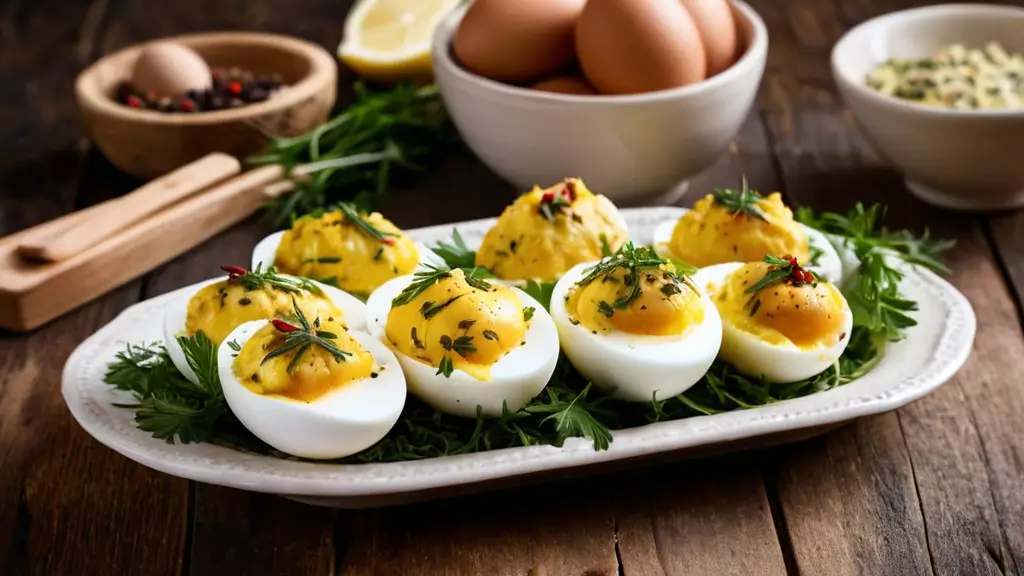
Essential Ingredients That Made Grandma’s Recipe Special
My grandmother’s stuffed eggs recipe starts with carefully picked ingredients. Years of making this family favorite taught me that quality ingredients create exceptional stuffed eggs.
Quality of farm-fresh eggs vs store-bought
Farm-fresh eggs make ideal stuffed eggs with their superior qualities. These eggs have less saturated fat and cholesterol, more importantly, they pack higher amounts of essential nutrients like Calcium, Lutein, Vitamin A, Vitamin E, and Vitamin D. You’ll notice farm-fresh egg yolks show richer colors and stay firmer, which helps them hold together better during prep work.
Store-bought eggs sit on shelves for 6-8 months before reaching customers. Farm eggs stand out with their thicker shells and denser contents because the chickens eat a varied diet of seeds, bugs, and fresh grass.
Simple pantry staples vs modern additions
My grandmother’s recipe uses simple ingredients that blend perfectly together. You need mayonnaise, mustard (Dijon gives better flavor), and a touch of pickle relish. Like in other traditional recipes, salt and pepper provide the essential seasoning.
These classic ingredients let the egg’s natural flavors shine. Modern recipes often add:
- Greek yogurt to boost protein
- Horseradish to add kick
- Curry powder to bring exotic flavor
But these extras can mask the clean taste that makes traditional stuffed eggs so special.
The role of homemade mayonnaise
Homemade mayonnaise is the life-blood of great stuffed eggs. Fresh mayonnaise beats store-bought versions with better taste and lets you adjust flavors to match your eggs perfectly. You’ll need room-temperature eggs, lemon juice, Dijon mustard, and the right oil.
Homemade mayonnaise lasts just a week. All the same, this short shelf life will give a fresh, flavorful result. Making mayonnaise from scratch lets you control what goes in and creates a richer, tastier mix for your egg filling.
Time-Tested Techniques for Perfect Stuffed Eggs

Perfect stuffed eggs need precise techniques that chefs have refined over generations. My extensive testing has found that success comes down to three vital stages: proper cooking, careful yolk preparation, and skilled filling techniques.
Proper boiling and cooling methods
The perfect cooked egg starts with the right method. Steaming is the quickest way compared to traditional boiling – you’ll need just half an inch of water. These timing guidelines will give you consistent results:
- Stovetop method: 12 minutes in hot water with 1 teaspoon baking soda
- Steamer basket method: 11-12 minutes of steaming
- Instant Pot approach: 5 minutes high pressure, 5 minutes natural release
The eggs need to go straight into an ice bath. This vital step stops the green-gray tinge around the yolk and makes peeling by a lot easier. Let them cool completely to get clean, intact egg whites.
The art of yolk preparation
Cut each egg lengthwise and take out the yolks with care. Instead of mashing with a fork, I’ve found that using the smallest holes of a grater or pushing yolks through a fine-mesh sieve makes the texture super smooth. This step breaks down the yolks completely and helps them mix better with other ingredients.
A hand mixer is a great way to handle bigger batches. This method makes everything smooth and adds air into the filling, which creates a lighter texture against the natural richness. Room temperature ingredients blend naturally and create a better mixture right away.
Traditional filling techniques
Whatever mixing method you pick, assembly needs careful attention. Cut a thin slice off each egg white’s bottom to create a flat surface. Your eggs won’t tilt or slide on the serving plate this way.
You have two options to fill the egg whites. A small spoon works fine for casual presentations, while a piping bag gives you elegant results. The piping method needs the mixture in a resealable plastic bag with a small corner cut off. You’ll get precise control over the filling amount and presentation.
You can make these eggs a day ahead if you store them right. Put the egg whites cut-side down on paper towels in a covered container. Add paper towels between layers to soak up moisture.
Why Simple Ingredients Create Better Flavor
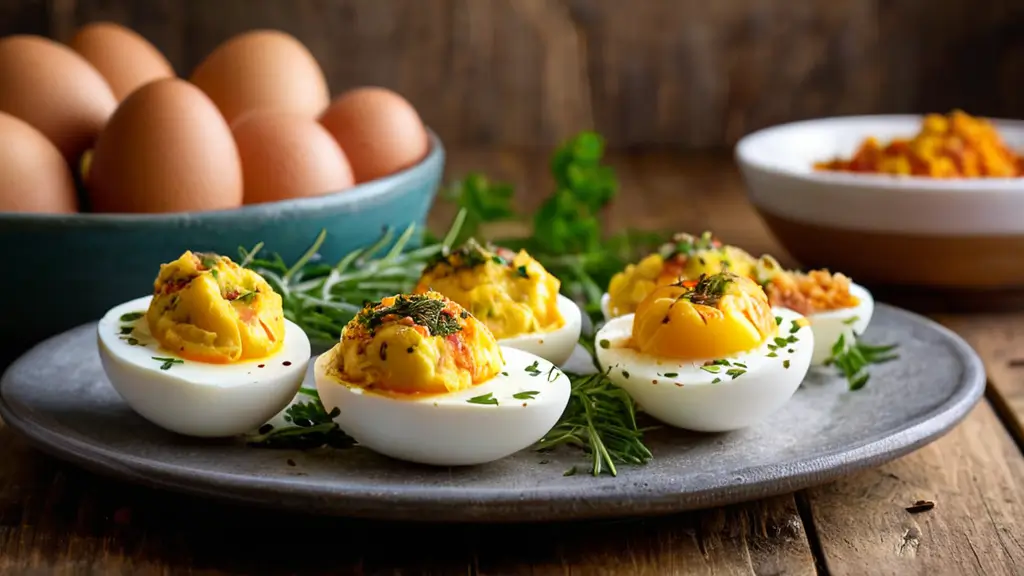
Taste makes or breaks a recipe’s success, and my grandmother’s stuffed eggs recipe shows this perfectly. Over the last several years of cooking, I found that eggs have more than 100 volatile flavor components. This makes them perfect for both simple and complex dishes.
Understanding flavor development
The magic behind stuffed eggs’ flavor comes from the egg yolks. These golden centers have natural fats that carry and improve the flavors of other ingredients. The yolks work as flavor carriers and create a perfect blend with other components. This is why recipes that focus on simple, quality ingredients give the best results.
The impact of ingredient quality
Quality ingredients can turn an ordinary stuffed eggs recipe into something special. Fresh eggs show bright yellow-orange yolks, which means higher nutrient content from well-fed hens. These eggs make fluffier textures and creamier fillings than store-bought ones.
The difference stands out even more since store-bought eggs are usually at least 30 days old. Fresh eggs give you:
- Richer, more buttery flavors
- Better texture consistency
- Higher nutrient content
- Superior binding properties
Less is more philosophy
My grandmother’s stuffed eggs showed the “less is more” principle beautifully. She knew that simple ingredients let eggs’ natural flavors shine instead of drowning them with too many additions. This matches research that shows eggs work well with other ingredients to create the perfect flavor profile.
Simple ingredients like mayonnaise, mustard, and basic seasonings improve the eggs’ natural taste when used carefully. Yes, it is why classic recipes have stood the test of time – they respect the basic flavors while letting subtle notes come through.
Traditional stuffed eggs recipes succeed because they create flavor harmony without getting complicated. This approach leads to a balanced and satisfying taste, showing that simple combinations often give the best results.
Preserving Family Legacy Through Recipe Traditions
Family recipes are rich sources of our past that preserve culinary traditions and heritage for generations. My experience with stuffed eggs recipes shows that these cherished dishes do more than feed us—they connect us to our roots and create lasting memories.
Passing down cooking wisdom
Teaching traditional cooking methods to younger generations builds more than culinary skills. We encourage strong family bonds and create opportunities to share stories and techniques. Parents and grandparents who teach children their favorite recipes pass along practical skills and family history.
The educational value goes beyond the kitchen. Children learn through hands-on cooking experience:
- Mathematical concepts through measuring
- Chemistry through ingredient interactions
- Confidence through accomplishment
- Cultural awareness through traditional methods
- Nutritional knowledge through ingredient selection
Creating memories in the kitchen
The kitchen is a special place where families create lasting memories together. We form our strongest associative memories through cooking because it involves all our senses. These shared experiences become treasured moments that children carry into adulthood.
Family cooking sessions give unique opportunities to tell stories and connect. Each step of preparing stuffed eggs recipes becomes a chance to share family history and create new traditions. These kitchen moments strengthen family bonds and build confidence in young cooks.
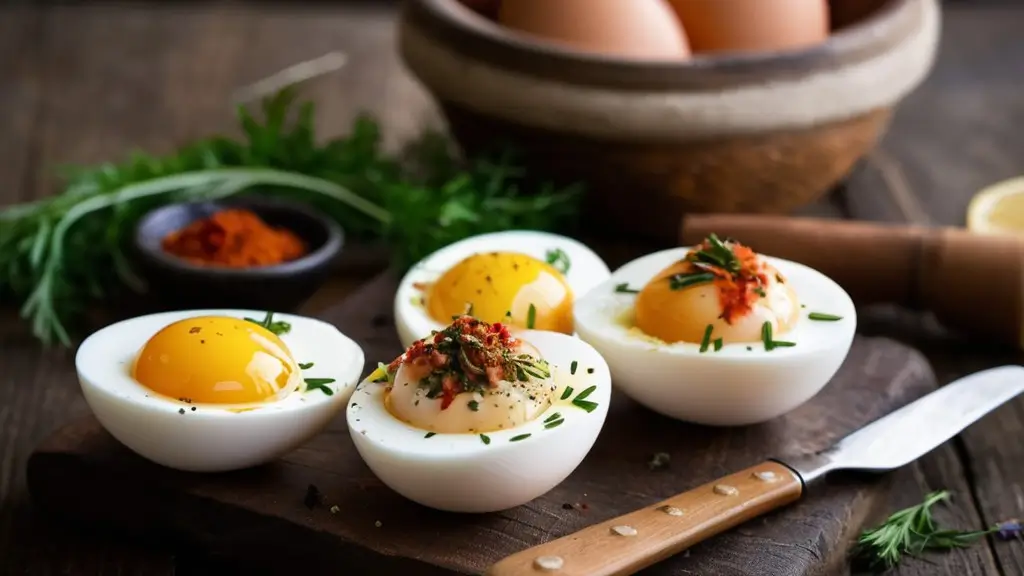
Maintaining authentic flavors
Authentic flavors need careful attention to traditional methods and ingredient selection. Food trends keep changing, which makes original recipes more valuable. Many families now document their recipes in different ways, from handwritten cards to digital collections.
Recipe preservation means more than writing down ingredients and steps. These documented recipes turn into family heirlooms, complete with notes about special techniques and personal variations. Stuffed eggs recipes often taste best with simple, traditional preparations that highlight quality ingredients’ natural flavors.
Family recipes’ value reaches way beyond the kitchen. These culinary traditions help identify immigration patterns, cultural changes, and family histories. Regular preparation and careful documentation ensure unique culinary heritage continues for future generations.
Conclusion
Simple ingredients create the most memorable dishes, as proven by traditional stuffed eggs recipes. My grandmother’s approach focused on proper technique and quality ingredients that produced better results than modern variations.
These time-tested recipes do more than just teach cooking – they keep our family stories alive and build lasting bonds between generations. Making these stuffed eggs takes me back to my grandmother’s kitchen where I learned valuable lessons about patience, attention to detail, and choosing the best ingredients.
This classic recipe shows why we shouldn’t overcomplicate some dishes. Natural flavors shine through when simple ingredients are prepared properly. These traditional stuffed eggs remain a family gathering favorite, showing that old methods often work best.
Family recipes like these need preservation and sharing. I hope you’ll explore your family’s cooking traditions. You can discover more recipes and dishes at recipesnutritious.com where we celebrate the time-honored cooking methods that bring families closer together.
FAQs
Q1. What are the key ingredients for classic deviled eggs? The key ingredients for classic deviled eggs typically include hard-boiled eggs, mayonnaise, mustard, salt, and pepper. Some recipes may also include pickle relish or vinegar for added flavor. The eggs are usually topped with a sprinkle of paprika for garnish.
Q2. How can I make peeling hard-boiled eggs easier? To make peeling hard-boiled eggs easier, try using eggs that are at least a week old, as fresher eggs tend to be more difficult to peel. You can also add a teaspoon of baking soda to the boiling water or use a steaming method instead of boiling. After cooking, immediately place the eggs in an ice bath to stop the cooking process and make peeling easier.
Q3. What’s the best way to achieve a smooth, creamy filling for deviled eggs? For a smooth, creamy filling, mash the egg yolks thoroughly using a fork or push them through a fine-mesh sieve. Mix in the other ingredients gradually, and consider using a hand mixer for extra smoothness. Room temperature ingredients blend more easily, resulting in a creamier texture.
Q4. How far in advance can I prepare deviled eggs? Deviled eggs can be prepared up to 2 days in advance. Store the egg whites and filling separately in airtight containers in the refrigerator. Fill the eggs just before serving to prevent them from becoming soggy. If you need to fill them ahead of time, cover them tightly and refrigerate for up to 24 hours.
Q5. Are there any creative variations on traditional deviled eggs? Yes, there are many creative variations on traditional deviled eggs. Some popular options include adding bacon bits, chives, or smoked paprika for extra flavor. You can also experiment with ingredients like curry powder, hot sauce, or even guacamole for unique twists. Just remember that simple, classic recipes often remain the most popular at gatherings.

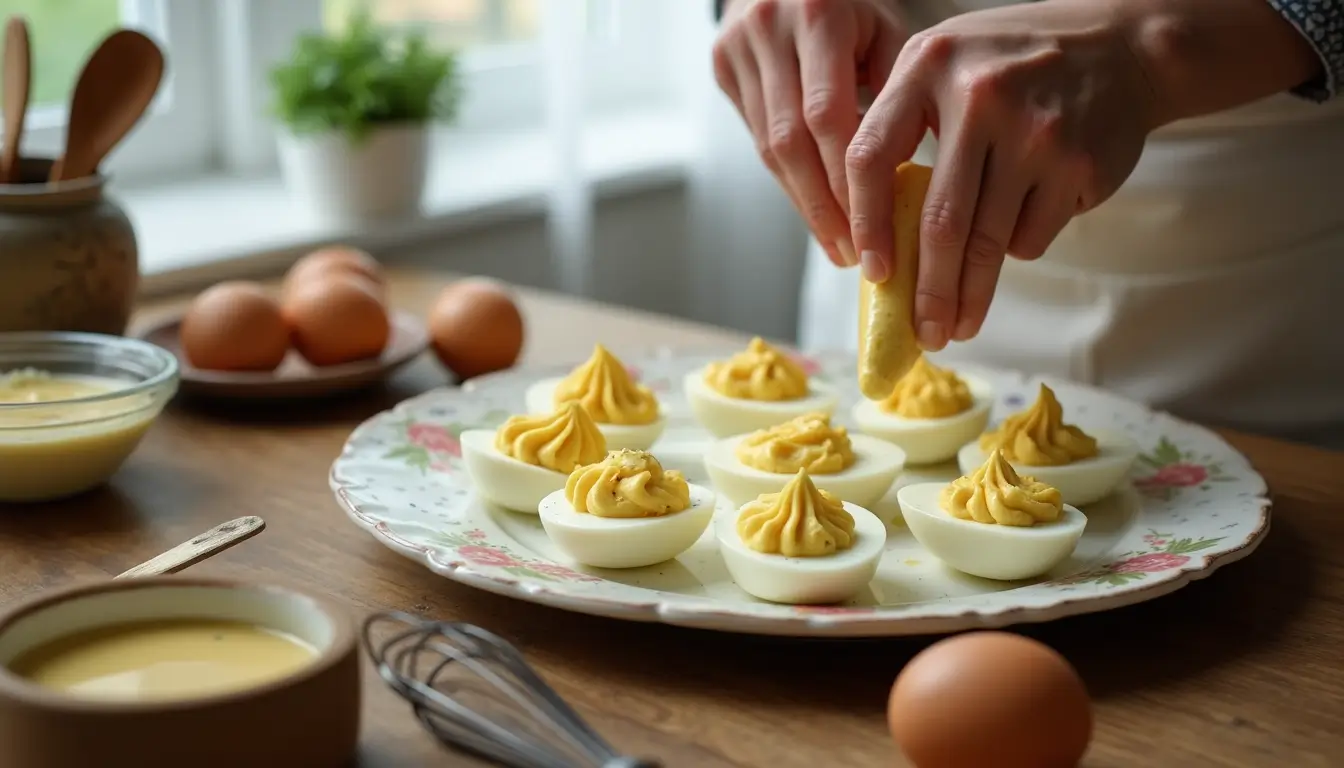
1 thought on “Why Grandma’s Stuffed Eggs Recipe Still Beats Modern Versions in 2025”
Comments are closed.